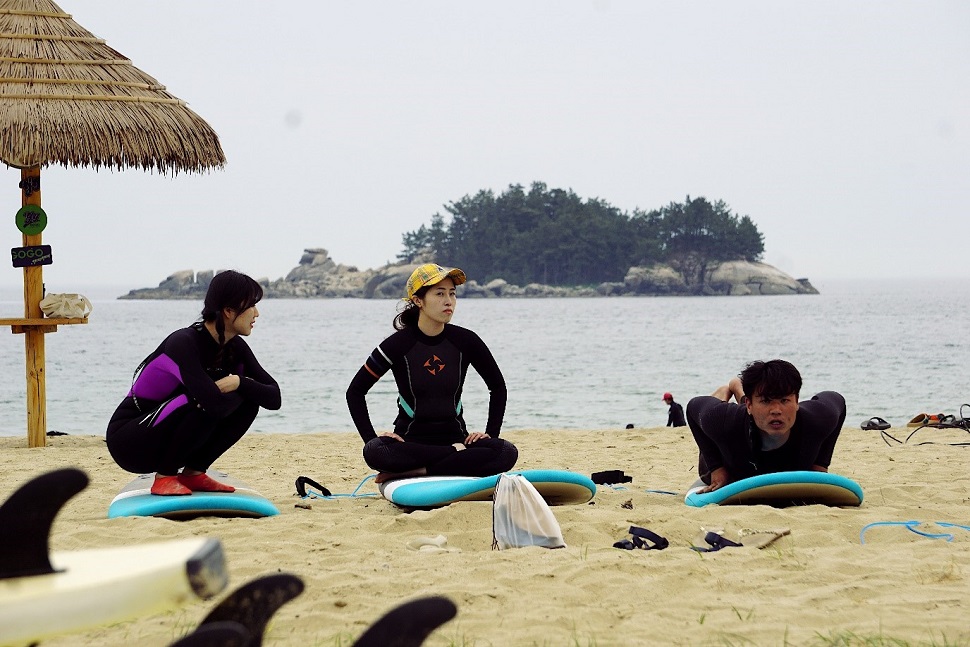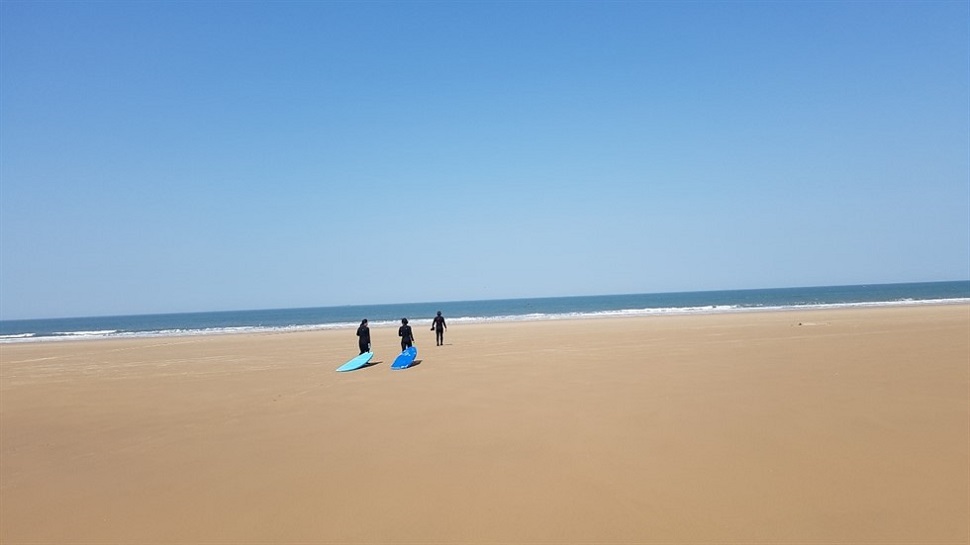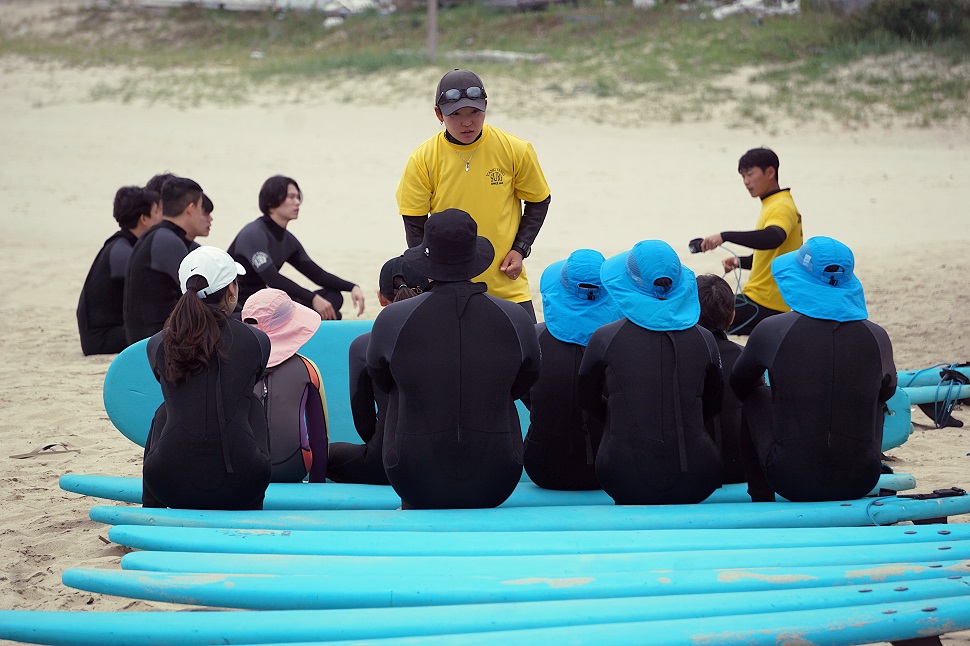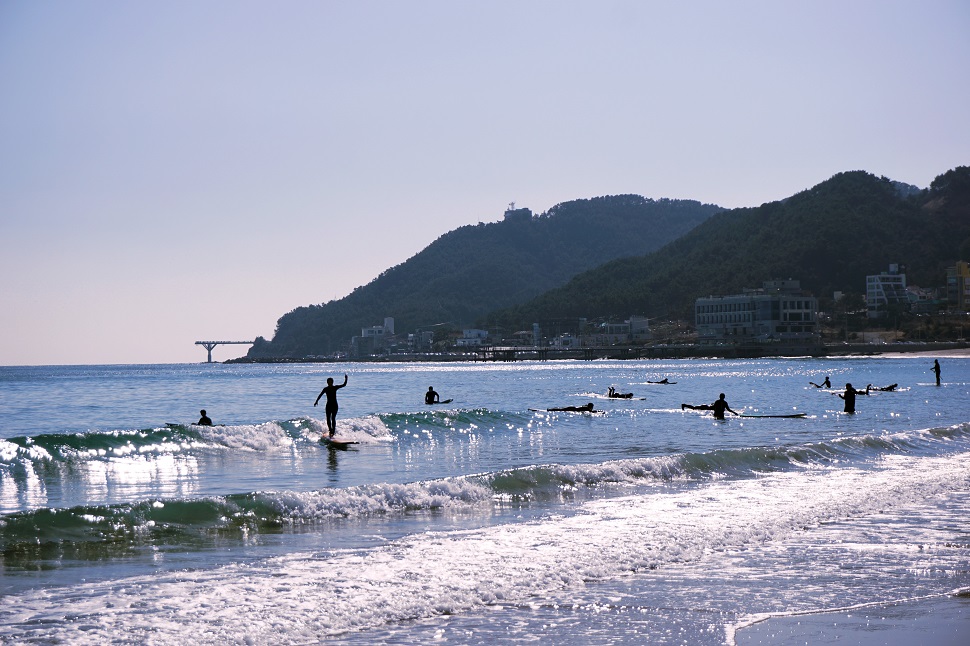[Jun] Surfing takes off in Korea
Date Jun 26, 2023
 A surf instructor, right, shows two beginners basic surfing techniques at Gisamun Beach, Yangyang-gun County, Gangwon-do Province, on the east coast of Korea, May 27, 2023. (Photo by Saul Latham)
A surf instructor, right, shows two beginners basic surfing techniques at Gisamun Beach, Yangyang-gun County, Gangwon-do Province, on the east coast of Korea, May 27, 2023. (Photo by Saul Latham)
The Korean wave, or hallyu, may be sweeping the world, but on the once-insular Peninsula – or at least the southern part of the Korean Peninsula – many Koreans have become obsessed with another kind of wave, surfing.
Korea’s history of surfing dates back to the 1990s, but recently crowds have been gathering to catch a big wave. Well, perhaps not necessarily big waves but more and more Koreans are taking to surfing more than just as a hobby. For many, it is a way of life, about connection with the natural world, thrills, self-confidence and health. Surfing is also accessible to anyone able and willing to get on a board.
Cheryl Kim, a lifelong surfer and businesswoman from Busan, learned to surf in Australia and continued surfing after moving to Korea. Over the past two decades, she has seen the sport mature at a local and national level.
“Initially the Korean surf scene was really small and there was a core group from Busan,” she said. “The first surf school was Songjeong surf school and the first surf shop was Surfers Dream.”
“Surfing has changed so much over the last 15-plus years. It pretty much went from a misunderstood marine sport that had lifeguards who couldn't swim, swimming out to rescue surfers who didn't need rescuing to representation by a group of young surfers at the ISA surf games in El Salvador this month (May).”
On the intertidal west coast in Taean-gun County southwest of Seoul is Mallipo, an ideal expanse of beach with variable waves suitable for beginners. Surfers can also meet larger swells if they pick the right time.
“The waves that come before and after typhoons are big and strong. So experienced surfers can enjoy the spot,” Lee Hyung-ju, owner of MLP Surf said. Lee surfs whenever there are waves. If that means in the winter then so be it. “This is our life,” he said. “No surf, no life.”
 Surfers on Mallipo Beach in Taean head out to practice riding the waves on a chilly April day in 2023. (Photo by Kim Ji-soo)
Surfers on Mallipo Beach in Taean head out to practice riding the waves on a chilly April day in 2023. (Photo by Kim Ji-soo)
Surfing may be typified as an exotic lifestyle culture associated with summer, as seen in the hugely popular surf hub of Surfyy Beach in Yangyang on the east coast. There, bars, bikinis and boards line the wide beach, and prevailing offshore winds regularly carve out clean ocean swells.
But for Korea’s die-hard pioneers, surfing is an experience worth chasing in the depths of winter. Much like monsoon season, winter often provides the best swells, even when beaches are covered in snow with icy water, blistering winds and dark skies.
Han Dong-hoon, or Hoony, CEO of WSB Farm, Korea’s first surf magazine, had seen this winter phenomenon growing. “Winter surfing in Korea is quite difficult as you know – super freezing,” he said. “But the number of people who are obsessed with winter surfing is increasing. There's definitely a big difference in numbers compared to just five years ago.”
Korea’s eastern coast meets a deeper sea, and its beaches are beautiful wide ribbons of golden sand lined with pine trees and impressive rocky outcrops. In 2015, Surfyy Beach in Yangyang opened and has since become the go-to destination for all things surf. Just south on the historic 38th parallel is Gisamun Beach, another section of the Yangyang coast providing right and left beach breaks and hosting plenty of beginner surfers and foreigners along with the locals. Up and down the coast are numerous beach breaks, including the lesser-known northernmost spot nicknamed “Squids” by locals.
Elsewhere, Jeju Island bares a rocky volcanic surf culture and beckons as a relatively uncharted island of discovery for surfing enthusiasts. Busan, the city that pioneered the local surfing movement, hosts a swathe of easily accessed ocean beaches and is a key spot on the peninsula’s surfing map. Since opening in 2020, Wave Park in Siheung’s Turtle Island, not far from Seoul, provides possibly the world’s best artificial waves graded for professional surfers down to anyone new to the sport.
As the country emerges from the shadows of the pandemic into the heat of another summer, it may be the ocean that provides waves of new vitality and the hope that people need as much as ever.
 Surf instructors, in yellow shirts, prepare beginners before they enter the cold late-spring water at Gisamun Beach on Korea’s northeast coast at the 38th parallel, Saturday, May 27, 2023. (Photo by Saul Latham)
Surf instructors, in yellow shirts, prepare beginners before they enter the cold late-spring water at Gisamun Beach on Korea’s northeast coast at the 38th parallel, Saturday, May 27, 2023. (Photo by Saul Latham)
 Early spring surfers brave the cold waters at Korea's original surf spot, Seongjeong Beach at Busan, February 2019. (Photo by Saul Latham)
Early spring surfers brave the cold waters at Korea's original surf spot, Seongjeong Beach at Busan, February 2019. (Photo by Saul Latham)

The Ministry of Culture, Sports and Tourism's "Korea Here & Now" work can be used under the condition of "Public Nuri Type 1 (Source Indication)."




